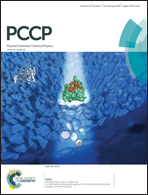A donor–acceptor pair for the real time study of vibrational energy transfer in proteins†
Abstract
Vibrational energy transfer (VET) is believed to play an important role in protein function. Theoretical studies predict highly directional, anisotropic VET in proteins. Distinct energy transfer pathways which connect distant functional sites in proteins have been proposed by simulations, indicating a function in allosteric communication. Experimental evidence for such pathways, however, is lacking. In small molecules, ultrafast vibrational pump–probe spectroscopy has been used to investigate VET between different parts of a molecule in great detail. Here, we address the requirements for extending this powerful approach to proteins and present a protein-compatible donor–acceptor pair for the real time investigation of VET. This VET pair consists of two non-native amino acids, β-(1-azulenyl)-alanine and azidohomoalanine, which can be positioned site-specifically and are found to be very well suited for spectroscopic studies of VET. Important for the study of proteins, co-translational incorporation of each of the amino acids has been demonstrated before using mutually independent approaches of protein engineering. We investigated the performance of the proposed VET pair in a model peptide which is designed to contain additional characteristic vibrational modes frequently used in infrared spectroscopy of proteins. Despite a larger inter-residue distance, we find that our VET acceptor generates a major signal that is easily observed compared to the other vibrational modes in the congested parts of the spectrum. We find sufficient signal size at concentrations compatible with proteins and over distances that will allow tracking of energy flow along predicted transfer pathways.


 Please wait while we load your content...
Please wait while we load your content...